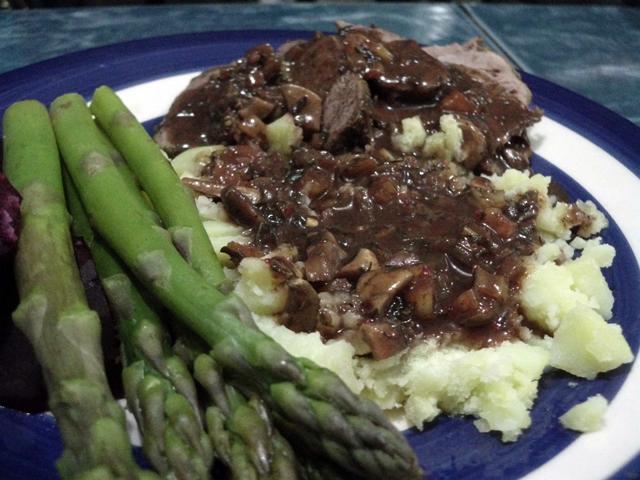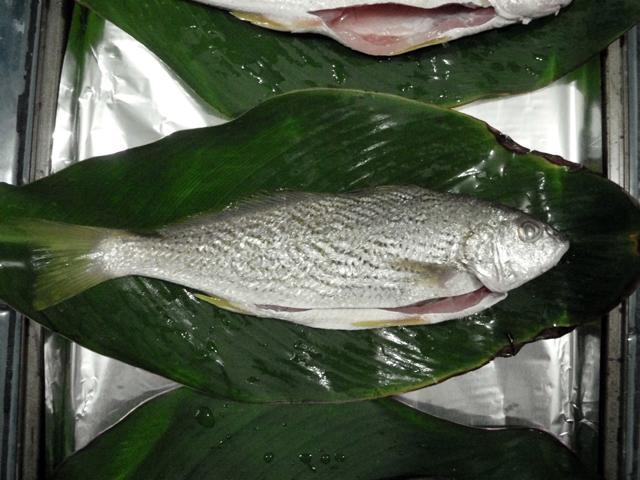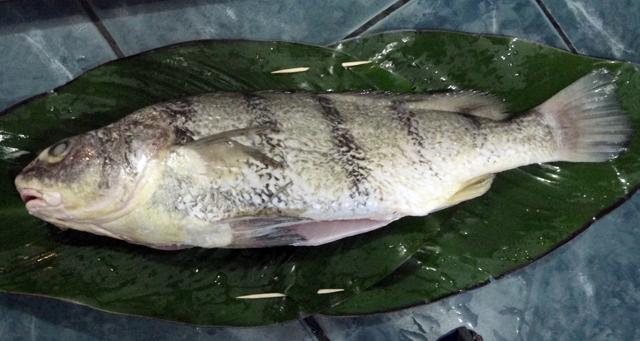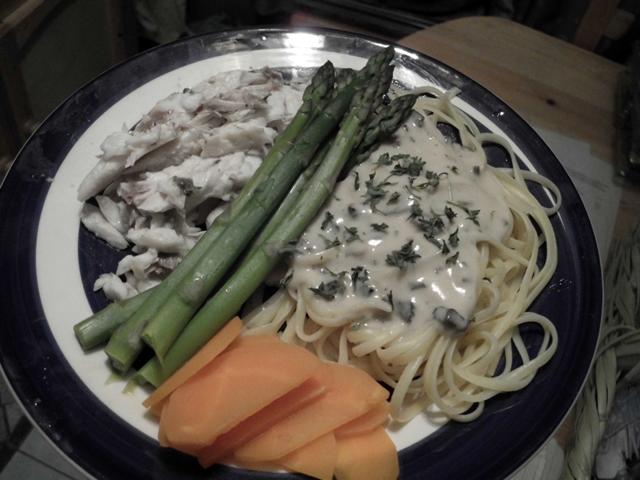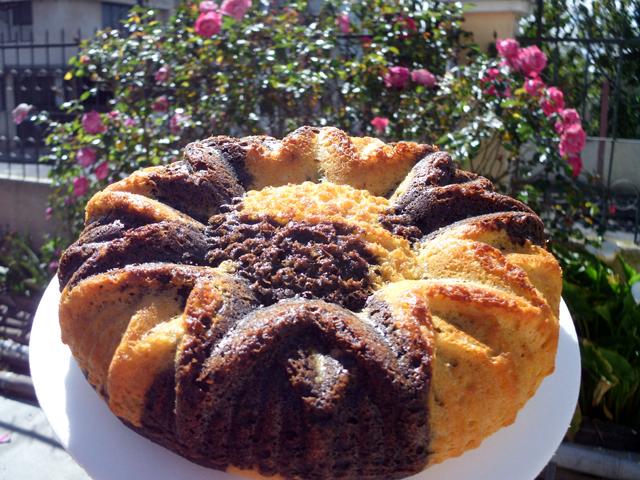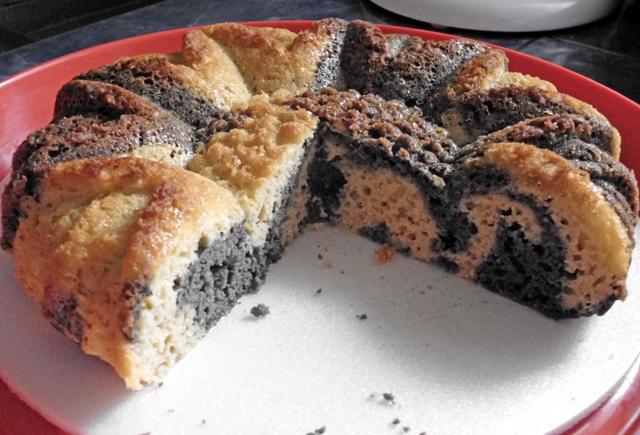-
Posts
2,383 -
Joined
-
Last visited
Content Type
Profiles
Forums
Store
Help Articles
Everything posted by Panaderia Canadiense
-
OK, I can report that the solution to the coffee sledgehammer was to add cream and just a hint of dark chocolate ganache to it. That levelled out the unpleasant part of the bitter flavour, brought down the proof, and added a really pleasant chocolate note without sweetening unduly. And here's a new question: has anybody played with nectarine liqueurs? Is there a trick to them beyond the usual sugar-booze-infuse?
-
Dcarch, I'm deeply jealous of your pandan sole. And can you give us a process for the rice puff shells? Those look like something I'd like to try with quinua.....
-
The canna leaves are a convenient, non-tinfoil way to cover and retain moisture. They impart a very subtle smoke flavour to whatever's cooked in them, but in the case of most fish it's so subtle as to not quite be there - basically, I have cooking cannas growing in my garden, and tinfoil is expensive. If I really don't recognize a fish, I'll ask the fishmongers or other customers at the market what they use it for - it's where I got the tip to pan-sear the Cazón de Leche - but generally the first time I try any fish I want it to be as neutral as possible so that I can judge the flavours on the same baseline. With fish that I recognize or am more comfortable with, you'll see recipes I know work. For example, black rock sole has been in the catch the past couple of weeks, and if it's in again I'll likely have the fishmonger fillet it for me so that I can panko and fry it.
-
All this talk of lamb lately gave me a craving. Hence: roast spring lamb with red-wine and mushroom gravy, mashed potatoes, and asparagus.
-
Ecuadorian name: Cazón de Leche English name: Soupfin Shark (among others) Size: presumably quite large; I bought it as 500g of steaks. Mom begged for something without bones this week, so we went for Cazón de Leche, a fish that the mongers described as soft and tasty without making any reference to it being a shark (which is usually a selling point). At this point I should probably say something about the Ecuadorian shark fishery - it's legal in a limited way for certain species, most notably Blue, Great White, Mako, and Soupfin, but with the stipulation that the shark must be caught on a line, not by dragging, and the entire shark must be used. In practice, this means that the fins are shipped to Asia and the body meat is sold locally - finning is not practiced as the fishermen regard it as unlucky, along with it being banned. The steaks were cut into smaller chunks and pan-seared in herb butter; the accompaniment was a baked ratatouille. I like the flavour of cazón, but not the texture in this sense; I'm going to try it in thinner strips as a tempura next to see if this ameliorates the softness somewhat.
-
Ecuadorian name: Rayado Chico English name: Striper Size: About 30cm long, about 300g each Here's one that made me laugh - last week I'd had the Rayado Grande, and this week was time for the Rayado Chico - the difference so far as the fishmongers are concerned is the size of the stripes. This was baked in Canna leaves, stuffed with ginger and lemons and rubbed with aliño paste. Hands down my favourite at this point. Tender, aromatic flesh that fell right off the bones, and I finished up wishing I'd bought at least one more so that I could have seconds.....
-
Ecuadorian name: Rayado Grande English name: Deep-sea Striped Bass, as far as I can tell. It's a deep-water perciforme for sure. Size: About 45-50 cm long, about 800g Here's a slightly perplexing fish - the Rayado Grande, which translates simply as "large-striped one" is by looks a sea bass of some sort. This one was large enough to feed three of us comfortably, and it was by no means the largest one available - if anybody recognizes it, I'd love to know what it actually is. I prepared this fish by rubbing the skin with aliño paste, then stuffing it with limes and basil, wrapping it in multiple Canna leaves, and baking for about an hour. The flesh was incredibly tender and almost basmati-fragrant; I'd definitely bake it in leaves again, but I'm also very intrigued by the idea of dredging it in a bit of seasoned flour and frying it.
-
I thought this might be an interesting topic. I have access to a really stellar fish market on Sundays, where a huge variety of seafood from Ecuador's waters, both fresh, brackish, and salt, is available. In the spirit of adventurousness, I've decided to eat my way through the fruits of the sea that are available to me, one species a week. To kick things off, here's the first fish we tried - I've been at this about a month so I do have a bit of a backlog to address. I'd also like to say at the outset that although Bonito and other strong Mackerel-type fish run in Ecuador's waters, you won't see them on my plate - I'm not fond of overly oily fish. The white- and pink-fleshed fishes, both whole and in chunks, will however be very well represented. === Ecuadorian name: Róbalo English name: Snook Size: About 30 cm long, about 250g each I stuffed the cleaned fish with orange wedges, rosemary, and fresh basil, then enclosed it in Canna leaves and baked for 45 minutes. No money shot when it came out of the oven, but here's how it ended up: Róbalo hang out in Ecuador's shrimp farms and in the natural shrimping grounds of the mangrove swamps, where they steal shrimp (hence their name, which means "steal it".) They're one of the most prized food fish in the country because of the meat's delicate shrimp flavour. I quite enjoyed this one, particularly in this presentation which kept the meat very moist and tender. I suspect that if I were able to find larger fish, it would also make quite tasty steaks on the grill.
-

Boiled corn from Korean market
Panaderia Canadiense replied to a topic in Elsewhere in Asia/Pacific: Cooking & Baking
Keith: There are literally thousands of different strains of Zea mays, all of which were selected for their various traits by the ancient Mesoamericans and South Americans; the brighter colours are not only food, but also have religious significance in many communities (to this day). They're all descended from the same species of grass, so the polymorphism is extremely low (compared to something like tomatoes, which are from five or six different species) and the cultivars cross-pollinate freely. Corn is wind-pollinated and to a lesser extent bee-pollinated, so it can and does cross borders, but each kernel in a cob is the result of one grain of pollen, so a single cob, like the ones pictured above, can contain genetic material for 2 or 5 or 6 of 10 cultivars.... Case in point: I grow yellow sweetcorn in my yard; I am fairly far away from anybody else growing corn so the wind will only self-pollinate my plants. However, my corn is also visited by carpenter bees, which are large wanderers. Last harvest, I had a couple of ears with random blue kernels in them; the closest blue corn to me is about 30 blocks away, and I'd guess that this is the effective range of my bees. So, by planting straight-up yellow, red, and blue corns, you would end up with multicoloured heads, but multicoloured corn produced that way is a trait that doesn't pass generationally - it's a result of random cross-pollination between the three colours. What does limit cross-pollination in corn, apart from wind and bee radius, is the time at which the plants are in flower. In order to get the multicoloured heads, all three plus of the varieties you grow have to come into bloom at roughly the same time in order for the pollen to be viable in producing the kernels. This is why corn is almost always planted in hills of two or three plants of the same variety: enough coming into bloom at the same time guarantees full pollination and therefore full cobs. The very fancy corns of six and seven colours that come from a single seed, like those shown in the last picture, are traditional cultivars, which are the result of generations of selective breeding; it's possible to get seed for some of them in the Americas but they're becoming more and more rare as the large-scale farms of gold sweetcorn dominate what's grown, especially in NorAm. Here in Ecuador at least there are seed banks to preserve our traditional corns (which are pretty cool - we have blues with pointed rather than rounded kernels and a whole range of reds to rusts that are nutty in flavour, as well as the giant-kerneled mote corns....) -
I do it all the time - the star is the only part you'll need to worry about - the attached aluminium pipe shouldn't have any issues. Citric acid is my soak of choice for protein-based clogs like boiled milk.
-
I'm quite fond of the Long Blonde Bomber, which is a shot of gold tequila dropped into a tall flute half-full of champagne.....
-
Simply that it's the freshest tea I can get my hands on. Other greens are available here in Ecuador, but they're generally imported and so agéd as to have lost all but the most brutish flavours.
-
I seem to recall that there have been studies done that showed that eating a bit of dirt, getting grubby, and eating with kid-grubby hands actually helped to bolster children's immune systems and led to a lower incidence of allergies.... These poor, neurotic parents nowadays who are so fixated with hygiene are probably doing their kids a disservice not only psychologically but also physically. Just saying, this really sounds like another instance of Helicopter Moms to me. At what point did children become so fragile that they were no longer allowed to find their own boundaries physically? BeeZee - my mom used to let me eat carrots out of the garden so long as I "wiped most of the dirt off in the grass first" - and to this day nothing tastes quite as good to me as a fresh-harvested carrot with still a bit of gritty garden soil stuck to it. With my young cousins, I do the same exact thing. They're kids, not grownups, which means that they should be getting dirty and drinking juice and not washing their hands obsessively, and yes, eating slightly dirty carrots that they wiped on the lawn. Equally, I'm absolutely the last person to restrict juice or cupcake intake at a party. Kids aren't stupid - they know this is a special occasion and that sweets like the cupcake are treats. Juice on the other hand? Jeez, I'm thrilled they want the fruit instead of artificially flavoured and coloured carbonated sugar water concoctions.
-
Sure. 8 oz of cream cheese, 4 oz of butter, 5 mL of orange juice (I use fresh), 5 mL of vanilla extract, with 4.5 oz of powder stevia and the remainder of 4 C (one pound, roughly) made up with whole powdered milk. Cream the butter and cheese together, add the OJ and vanilla, then add the stevia/milk blend until a thick icing forms. EDIT - if you don't have access to powder-form stevia (and you may not - it's uncommon even here) you can substitute about 50-60 drops of the liquid; in this case, add it when you add the OJ and vanilla.
-
I do a lot of baking for diabetics.... In the cake itself you can raise the protein levels by substituting whole milk powder for some of the sugar (or all of it, if you're going to use a non-sucrose sweetener in place of the sugar) and by cutting a portion of the oil with yogurt. This helps to level out the blood-sugar spikes produced by the carbs. Nut flours are still carb-heavy but are also higher-protein, which contributes to a smoother rise in blood sugar than wheat or alternate grains do. For the icing, I've had great luck with a mixture of milk powder, stevia, and cream cheese, with vanilla and a touch of orange juice. 0.9 oz of stevia is the equivalent, sweetness-wise, to 1 C of 10x confectioner's sugar.
-
I'm very partial to fresh green tea from the Sangay plantations here in Ecuador.....
-
Stuart: Chicha de Aguacate or Chicha de Palta (Palta, btw, is the name for the avocado from Peru south - Ecuador and north uses Aguacate, and this largely because there was an actual tribe of people called Paltas in Ecuador and Colombia, who had trade northwards). The leaves are chewed up and spit into a vessel (these days a plastic one, but most authentically it should be clay) along with either manioc root or plantain and allowed to ferment lightly until it's sort of fizzy.... There are better chichas available; the best chicha de aguacate I've ever tried was made with both the leaves and the fruit.
-
Oenophile. Enophile is a result of the incorrect elimination of the œ dipthong for modern readers, and results in an incorrect pronunciation to boot....
-
The roe I'd treat as any other roe or caviar - salt it lightly and with care. Then I'd be really tempted to make little balls of it, stuff it into flake pastry, and deep fry it.
-
I'd omit the water in the pan and bake for slightly less time in a hotter oven - say, 45 minutes to an hour at 325 rather than 2 hours at 250. That way you should hit a happy medium between fully cooked, non-cracked cakes and crisp crusts.
-
Couldn't agree more. Last time I was back in Canada I considered some peaches at the supermarket, but they smelled like cardboard. The ones off my tree here at home smell engagingly and complexly like peaches, and taste like 'em too. If I don't know what's in it and it's a prepared dish at a comedor or similar, or at a roadside cart, I'll try it once. If it's a prepackaged deal with a list of ingredients as long as my arem, that have more than 2 or 3 syllables and very chemical names, it's not going in my belly.
-


